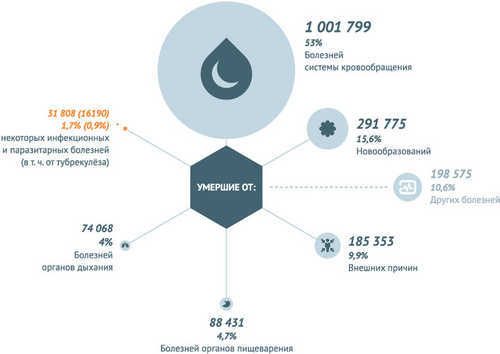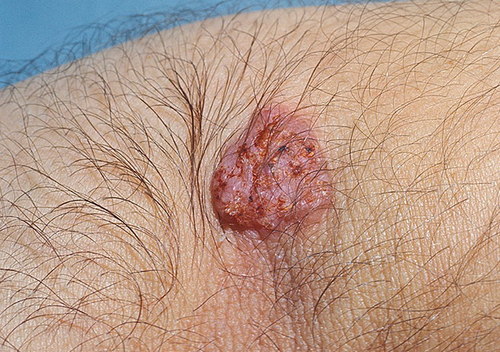Worldwide disease caused by Streptococcus pneumoniae (S. Pneumoniae or pneumococcus) and the associated pneumotropic infections, represent one of the most serious problems for public health.
Isolated invasive and non-invasive forms of pneumococcal disease. To invasive pneumococcal infection (IPI) is a range of serious and life-threatening diseases: bacteremia with no apparent focus of infection, meningitis, pneumonia, sepsis, pericarditis, arthritis.
Non-invasive forms of pneumococcal infection is bronchitis, community acquired pneumonia, otitis media, sinusitis, conjunctivitis.
According to statistics 70% of all pneumonias and about 25% of otitis media, 5-15% of purulent meningitis, approximately 3% of endocarditis is caused by S. pneumoniae S. Pneumoniae.
Pneumococcal infection usually is a complication of other infections. Examples are pneumococcal pneumonia, inflammation middle ear (otitis media) in children after or on a background of influenza or measles, or any other respiratory viral infection.

Pneumococcal infection is spread by airborne droplets, for example, when coughing (especially at close contact). The source of infection can be a person without any clinical manifestations. Information about seasonality for diseases caused by S. Pneumoniae, is quite controversial. However, a number of authors have noted the increased incidence in autumn and winter, typical of a number of other pneumotropic infections.
Children first years of life are the main carriers of the pneumococcus, infecting adults. In normal adults the carrier frequency of 5-7% among adults living with children, it reaches 30%.
THE PROBABILITY TO BE ILL
The highest incidence of severe pneumococcal infections occur in children under 5 years of age and among the elderly (over 65 years). Especially vulnerable to Streptococcus pneumoniae are young children under 2 years old, whose body is unable to resist infection. For this age group is infection number 1 and the most frequent cause of severe forms of pneumonia, otitis media, meningitis. Among the elderly, the most vulnerable are those who reside in special care homes for the elderly.
In addition, high risk groups on the incidence of pneumococcal infection are children and adults with chronic diseases of the cardiovascular and respiratory systems, diabetes, liver cirrhosis, chronic renal failure, Hodgkin’s disease; children and adults with hematologic diseases; HIV; children and adults with leakage of cerebrospinal fluid; children and adults after cochlear implantation; children and adults with sickle cell disease; anatomic asplenia, or planning or have undergone splenectomy.
This also should include the so-called “organized” contingents (children attending kindergarten, students living in dormitories, military personnel, residents of homes for the disabled, prisoners and other adults and children residing in crowded conditions). The presence of harmful habits (alcohol, Smoking) also applies to the risk factors.
SYMPTOMS
The symptoms of pneumococcal infection that causes pneumonia include fever, cough, shortness of breath and chest pain. The symptoms of pneumococcal purulent meningitis – stiff neck, severe headache, fever, confusion and disorientation, and photophobia. The initial symptoms of pneumococcal bacteremia (blood infection, the most severe form with mortality rates up to 50%) may be similar to some symptoms of pneumonia and meningitis, but also include joint pain and chills.
In this regard, doctors again and again warned of the dangers of self-medication! Do not attempt to fight the disease on their own, guided as manuals commercials for the various drugs and their availability in drugstores.
COMPLICATIONS AFTER THE DISEASE
Particular weight is different pneumococcal meningitis, the frequency of which is about 8 per 100 thousand children under 5 years. On average, about 83% of the cases occur among children under the age of 2 years. Despite the fact that the pneumococcus Streptococcus pneumoniae occupies the third position after Haemophilus influenzae type b (Haemophilus influenzae type b) and Neisseria meningitidis (meningococcal disease) as the infectious agent responsible for the development of the disease, the prognosis of pneumococcal meningitis is much more serious. Complications such as mental retardation, disorders of motor activity, epilepsy and deafness occurs significantly more often than in the outcome of bacterial meningitis of other etiologies.
Pneumonia caused by the pneumococcus S. pneumoniaeis the most frequent lung complicated by empyema (accumulation of pus in the pleural cavity, causing a decrease in respiratory surface of the lung tissue), causing death (up to 2/3 of cases of empyema). In Russia of 500 thousand cases of pneumonia per year pneumococcal etiology are 76% of adults and 90% in children under 5 years. The frequency of pneumococcal pneumonia among children less than 15 years amounts to 490 cases per 100 thousand, under 4 years – 1060 cases per 100 thousand.
Pneumococcal bacteremia in the majority of cases (80%) occurs with symptoms of fever without focus of infection. The incidence of bacteremia, is due to S. pneumoniae, is 8-22% in children of early age. It pneumococcal sepsis with the development of severe shock, organ damage is most severe and ginepraia form of pneumococcal infection. The incidence of this nosological form in children under 5 years has averaged 9 000 cases per year; mortality reaches 20-50%.
According to world statistics, the proportion of pneumococcal otitis media ranges from 28 to 55% of all registered cases. Pneumococcal acute middle ear infections have a more severe course and high risk of complications otogenny, a penchant for including perforation of the eardrum. Pneumococcal otitis media is the most common cause of hearing loss in children.
The risk of developing pneumococcal infections:
- Healthy risk is 8.8 per 100,000.
- In patients with diabetes – of 51.4.
- In adults with chronic lung disease – of 62.9.
- In patients with chronic heart disease – 93,7.
- those suffering from cancer – 300,4.
- HIV-infected – 422,9.
- In patients with hematologic diseases – 503,1 per 100,000.
MORTALITY
According to who, pneumococcal disease is considered the most dangerous of all preventable diseases and vaccination before the introduction of the universal vaccination annually causes the death of 1.6 million people, of which 0.7-1 million children, accounting for 40% of deaths of children in the first 5 years of life.
TREATMENT
A global problem in the world is the higher stability (resistance) of pneumococcus to antibiotics – this means that treatment of pneumococcal infection with antibiotics is often ineffective. The main factor of development of antibiotic resistance of pneumococcus is the irrational administration of antibacterial drugs. During the monitoring carried out in 2004-2005, 11% of pneumococcal strains were resistant to penicillin and 7% to macrolides, 40,8% – to co-trimoxazole.
But in 2011-2012, a similar study showed that 29% of strains of S. pneumoniae have a reduced sensitivity or resistant to penicillin, 26% of strains resistant to macrolides, 50% of the strains to co-trimoxazole. According to the latest data, up to 10% strains pneumococcal infection acquired resistance to combinations of penicillin with broad spectrum inhibitors of β-lactamase that prognostically extremely unfavorable, because with the rapid development of the disease (2-3 days) time for determination of sensitivity to antibiotics, as a rule, no, and patients with severe pneumococcal infection often die, despite the introduction of the standard antibacterial drugs.
THE EFFECTIVENESS OF VACCINATION
According to who, global experience has shown that mass vaccination of more than 80% reduces the incidence of pneumococcal meningitis and severe pneumonia in children, and more than one – third the incidence of all pneumonias and ear infections. Carriage of Streptococcus pneumoniae in children is reduced, consequently less sick and unvaccinated children and adults. According to forecasts of the world health organization, global use of vaccination against pneumococcal infection will help prevent a 5.4 – 7.7 million child deaths by 2030.
Vaccination is the only highly effective method to significantly affect morbidity and mortality from pneumococcal infections and reduce the level of antibiotic resistance of S. pneumoniae. With the confirmation of safety and efficacy of pneumococcal conjugate vaccines, who and UNICEF consider it necessary to include these vaccines in all national immunization programmes. It should be note that the maximum protective effect is achieved by routine vaccination of all children up to 2 years, and not only patients at risk.
VACCINES
For pneumococcal disease vaccination has been used for over 30 years. Since 1981 has been applied to pneumococcal polysaccharide vaccine. Since 2000, the international practice for immunoprophylaxis of pneumococcal infection in children of early age began to be used pneumococcal conjugate vaccines.
Today in Russia registered the following vaccines: two pneumococcal conjugated vaccines (10-valent and 13-valent – ПКВ10 and PCV 13) and one polysaccharide 23-valent (ППВ23). The latter is used in children older than 2 years and adults. While conjugate vaccines are recommended for immunization of children 2 months of age and adults aged 50 years and older. PCV13 is also registered in the U.S. and the EU for use in broader age groups (for children ages 6 weeks – 17 years and adults aged 18 years and older). In the near future in Russia is also expected to expand the age indication for PCV13.
In 2013, pneumococcal conjugate 13-valent vaccine “Превенар13” was awarded the Galen award as best biotechnology product of the year.
THE LAST OUTBREAK
Most diseases are sporadic. Outbreaks of pneumococcal infection are unusual, but may occur in closed groups, for example, homes for the elderly, day-care hospitals and other institutions of this kind. However, large outbreaks of meningitis caused by serotype 1, was registered in the African meningitis belt.
Who estimates that of the 8.8 million children under 5 years who died in 2008, 476 000 (333 000 – 529 000) deaths were caused by pneumococcal infection. Levels of morbidity and mortality higher in developing than in developed countries.
HISTORICAL INFORMATION AND INTERESTING FACTS
Pneumococcus was identified quite some time ago in 1881, But the vaccine was began to develop only in the second half of the XX century the Difficulty of creating such vaccines was and is in a huge number of types of pneumococcus.




Get 10000 Visitors To Your Site $39
Great post. I am facing a couple of these problems.
Hello there! I just wish to offer you a big thumbs up for the great info you have right here on this post. I will be coming back to your blog for more soon.